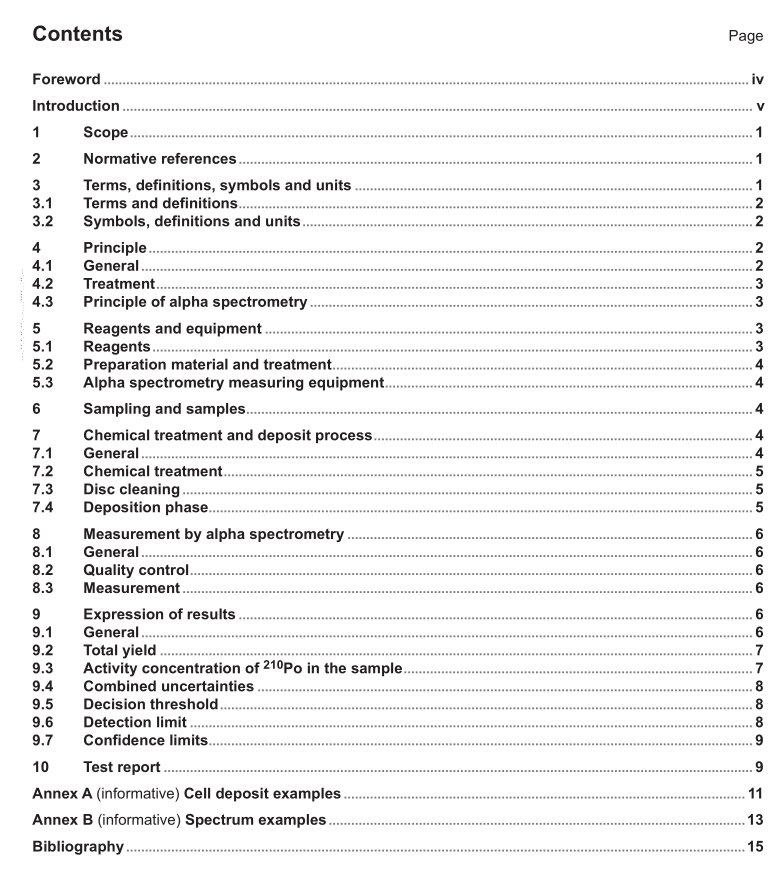ISO 13161 pdf download

ISO 13161 pdf download Water quality — Measurement of polonium 210 activity concentration in water by alpha spectrometry
When 208Po is used, its decay shall be taken into account in accordance with the information given on thecalibration certificate.
NOTE The half-life of 209Po and its associated uncertainty commonly used was subjected to a recent investigationthat suggests an uncertainty of +25 % instead of 4,8 %(Reference [14]).
5.1.3 Concentrated hydrochloric acid,37 % mass fraction, or concentrated nitric acid.
5.1.4 Dilute hydrochloric acid or dilute nitric acid, to adjust the pH at the beginning of the treatment.
5.1.5Ascorbic acid or hydroxylamine hydrochloride.
5.1.6 Ethanol.
5.2Preparation material and treatment
The preparation material should be appropriate for the operating method used(Clause 7).
5.2.1 Standard laboratory equipment, including filtration material, hot plate, pH meter or pH paper.
5.2.2Analytical precision scale.
5.2.3Stirrer.
5.2.4 Equipment for the preparation of the thin layer deposit.
5.2.5 Metal disc, of a metal that allows reductive deposition of polonium (e.g. stainless steel [304L type].silver, nickel or another metal displaying this property).
5.3Alpha spectrometry measuring equipment
The alpha spectrometry counting can be carried out using either gridded ionization chambers or thinsemiconductor detectors.
A spectrum display is essential.
6 Sampling and samples
lt is important that the laboratory receives the test sample as soon as possible.
Carry out sampling, handling, and storage as specified in ISO 5667-1 and lSO 5667-3.
7 Chemical treatment and deposit process
7.1General
The volume of the test sample is variable; the usual quantity is between 150 ml and 2 000 ml.
Where necessary, the test sample can be filtered on a flter of 0,45 um porosity (the use of a single-use filteringdevice is recommended).
The verification that any contamination of reagents and residual contamination in the analytical equipment arebelow the detection limit for the analysis shall be carried out and documented (blank analysis).
The analysis shall be carried out under a fume-extracting hood.
NOTE lf large test samples are used, or if a special study is being carried out,it is possible that a preliminaryconcentration prior to the first step of chemical reatment is necessary, e.g.co-precipitation of Fe(OH)g adding Fe3+ canbe used. If this co-precipitation is used, the volume of analysed sample can be large and the detection limit decreases inthe same proportion.
7.2Chemical treatment
Take an aliquot of volume V from the test sample, e.g. 500 ml.
Adjust the pH with concentrated hydrochloric acid or concentrated nitric acid (5.1.3) in order to reduce the pHbeiow 1,5.Add a known quantity of tracer solution (5.1.2) in order to enable the determination of the chemicalyield without introducing large measurement uncertainties and avoiding contamination of the laboratoryequipment. ldeally the 210Po and the tracer peaks should be of the same magnitude (an ideal aim is theacquisition of between 400 counts and 10 000 counts in the tracer peak).
At this stage,a concentration step [dry evaporation and addition of dilute hydrochloric acid (5.1.4)] can becarried out by slow evaporation at a temperature lower than 80 °C (to avoid losses of Po) to dryness and thenadd, for example, 20 mi of 6 mol/l HCI.
Adjust the volume of the solution to approximately 100 ml with water(5.1.1).
A final HCl concentration between 0,1 mol/l and 3 mol/l and consistent use of the same concentration in orderto maintain the repeatability level are recommended.The final volume can vary from 50 ml to 100 ml.
7.3Disc cleaning
The disc shall be thoroughly cleaned in order to remove deposits of organic impurities, e.g. using ethanol;itmay also be necessary to remove surface oxide deposits with dilute hydrochloric acid.
NOTE ln the case of unprotected silver discs, the oxide and sulfur deposits present on the surface can be eliminatedby polishing or by washing with dilute ammonia solution.
Rinse the disc with water.
7.4Deposition phase
Transfer the solution to the deposition equipment(Annex A) and add an excess of the reducing agent, e.g.0,1 gof ascorbic acid or hydroxylamine hydrochloride (5.1.5).
During the deposition phase, the metal disc catalyses the reduction of the polonium from Po4+ or Po2+ to metallicpolonium. The addition of a reducing agent in the solution prevents the reoxidation (and therefore redissolution)of the deposited polonium on the disc by any oxidants that may be present in the solution, e.g.Fe3+.
Stir the solution continuously using an automatic stirrer during the entire deposition phase.
The reduction kinetics of Po4+ or Po2+ to metallic polonium are slow at room temperature. The deposition ratecan be accelerated by heating the solution to a maximum of 90 °C, making sure that the solution is in permanentcontact with the metal disc, without excessive bubbling. Therefore, it is advisable to limit evaporation losses bykeeping the acidity of the solution low.This phase shall be long enough to allow a good deposition yield and innormal circumstances is complete within 3 h.









